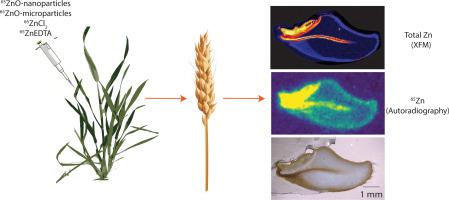Science of the Total Environment ( IF 9.8 ) Pub Date : 2020-09-15 , DOI: 10.1016/j.scitotenv.2020.142369 C.L. Doolette , T.L. Read , N.R. Howell , T. Cresswell , E. Lombi

|
Foliar zinc (Zn) fertilisers can be used to supplement or replace soil applications of Zn in situations where soil properties may decrease the plant bioavailability of Zn. However, conventional foliar Zn formulations such as zinc sulfate can cause leaf damage due to the rapid release of high amounts of Zn2+ into leaf tissue which can be locally phytotoxic. Zinc oxide nanoparticles (ZnO-NPs) offer an alternative approach by providing a more sustained release of Zn into leaf tissue, and potentially avoiding the need for multiple applications. We compared the efficacy of ZnO-NPs and microparticles (ZnO-MPs) to that of conventional formulations (ZnCl2 and ZnEDTA) in wheat. This is the first study to use 65Zn radiolabelled formulations and gamma spectrometry to determine the translocation of Zn to the grains and subsequent efficiency of foliar-applied ZnO-NP fertilisers. We found that ZnEDTA was the most efficient fertiliser in terms of the proportion of applied Zn translocated to wheat grain. We also investigated the effect of Zn application rate on fertiliser efficiency. For all forms of Zn, when plants were treated with Zn at 750 mg/L or 75 mg/L, there were no significant differences in the concentration of applied Zn translocated to the grain. This suggests that current Zn application rates could be decreased while still maintaining the nutritional quality of grain. Finally, using photo-stimulated luminescence (PSL) autoradiography and synchrotron-based X-ray fluorescence microscopy (XFM) we showed that the grain distribution of foliar-applied Zn mirrors that of Zn derived from root uptake.
中文翻译:

叶面施用的纳米颗粒肥料中的锌易位到小麦籽粒中:一项比较传统和新型叶面肥料的65 Zn放射性标记的易位研究
在土壤特性可能会降低植物的锌生物利用度的情况下,叶面锌(Zn)肥料可用于补充或替代土壤中的Zn施用。但是,由于大量的Zn 2+迅速释放到叶片组织中,这可能是局部植物毒性的,因此常规的叶面Zn制剂(例如硫酸锌)会导致叶片受损。氧化锌纳米颗粒(ZnO-NPs)提供了另一种方法,可以使Zn更加持久地释放到叶片组织中,并有可能避免多次应用的需要。我们将ZnO-NP和微粒(ZnO-MPs)的功效与常规配方(ZnCl 2和ZnEDTA)在小麦中的功效进行了比较。这是第一个使用65的研究锌放射性标记配方和伽马能谱法测定锌向谷物的转运以及随后施用叶面施用的ZnO-NP肥料的效率。我们发现,就施用的锌转移到小麦籽粒中的比例而言,ZnEDTA是最有效的肥料。我们还研究了锌施用量对肥料效率的影响。对于所有形式的Zn,当用750 mg / L或75 mg / L的Zn处理植物时,转运到谷物上的Zn浓度没有显着差异。这表明可以降低当前锌的施用量,同时仍保持谷物的营养质量。最后,



























 京公网安备 11010802027423号
京公网安备 11010802027423号